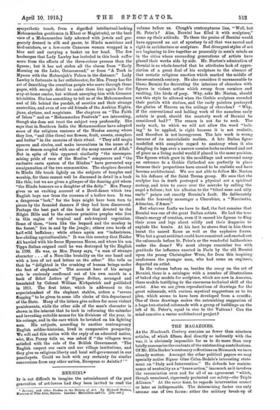BERNINL• Iv is not difficult to imagine the astonishment of
the past generation of art-lovers had they been invited to read the
• Benson, and other StuAiss in ihe History of Art. By Richard Horton, kneennsof Pino Arts, Boston. London: Macmillan aad Co. Mtn nen] volume before us. Clough's contemptuous line, "Well, but St Peter's ? Alas, Bernini has filled it with sculpture," sums up their attitude. To them the praise of Bernini would have appeared an act of apostasy to all that was sacred and right in architecture or sculpture. But divergent styles of art are beginning to lire together as peaceably in men's minds as in the cities where succeeding generations of artists have placed their works side by side. Mr. Norton's admiration of Bernini is so whole-hearted that he attributes lack of appre- ciation of a great deal of his scolpture to the absence of that ecstatic religious emotion which marked the middle of the seventeenth century. He also considers it unreasonable to blame Hernia; for decorating the interiors of churches with figures in violent action which swoop from cornices and vaulting, like birds of prey. Why, asks Mr. Norton, should not this style be allowed when the Gothic sculptors crowded their portals with statues, and the early painters portrayed the glories of Heaven on the ceilings of churches P "Why, if the conventional and halting work of the nameless early artists is good, should the masterly work of Bernini be considered bad!" The reason is not far to seek. The early work, to which we will not allow the word " halt- ing" to be applied, is right because it is not realistic, and therefore is not incongruous. The late work is wrong because of its materialistic realism. A late Italian figure modelled with complete regard to anatomy when it sits dangling its legs over a narrow cornice looks as absurd and out of place as a living model would if placed in the same position. The figures which grow in the mouldings and surround many an entrance to a Gothic Cathedral are perfectly in place because their proportions have ceased to be realistic and bare become architectural. We are not able to follow Mr. Norton in his defence of the Saint Teresa group. He sees that the sculptor has in truth portrayed a physical not a spiritual ecstasy, and tries to cover over the mistake by calling the angel a failure ; but his allusion to the "tilted nose and silly smile" points out exactly Bernini's fault. He deliberately made the heavenly messenger a Cherubino, a "Narcisetto, Adoncino, d'Amor."
But whatever faults we have to find, the fact remains that Bernini was one of the great Italian artists. He had the true titanic energy of creation, even if it caused his figures to fling their arms and legs about wildly and their draperies to explode like bombs. At his beet he shows that in him there burnt the sacred flame as well as the explosive forces. Who but a great architect could have conceived and carried out the colonnade before St. Peter's or the wonderful baldacchino under the dome P We must always remeinber too with gratitude the influence exerted in Paris by the old Bernini upon the young Christopher Wren, for from this inspiring conference the younger man, who had come an engineer, departed an artist.
In the volume before us, besides the essay on the art of Bernini, there is a catalogue wills a number of illustrations of baked clay models for sculpture, which are now in America, these models testifying to the enormous technical skill of the artist Also we are given reproductions of drawings for the great colonnade, with curious mystical suggestions as to its plan, which seems to have been developed from a crucifix. One of these drawings makes the astonishing suggestion of a huge two-storied colonnade with a group of buildings on the left of St. Peter's, equal in size to the Vatican I Can the mind conceive a vaster architectural project P






































 Previous page
Previous page